| Revision as of 12:33, 18 September 2024 editReplayerr (talk | contribs)Extended confirmed users1,838 editsm Replayerr moved page The Egyptian invasion of Harar to The Egyptian Invasion of Harar← Previous edit | Revision as of 12:37, 18 September 2024 edit undoReplayerr (talk | contribs)Extended confirmed users1,838 editsNo edit summaryNext edit → | ||
| Line 1: | Line 1: | ||
| {{Short description|1874–1885 military conflict in the Horn of Africa}} | {{Short description|1874–1885 military conflict in the Horn of Africa}} | ||
| {{Infobox military conflict | {{Infobox military conflict | ||
| | conflict = Egyptian |
| conflict = Egyptian Invasion of Harar | ||
| | image = Ottoman_Egypt.png | | image = Ottoman_Egypt.png | ||
| | caption = The Modern Egyptian Empire | | caption = The Modern Egyptian Empire | ||
| Line 28: | Line 28: | ||
| }} | }} | ||
| The '''Egyptian |
The '''Egyptian Invasion of Harar''', was part of a conflict in the ] between the ], ], and ] tribesmen, and the ] from 1874 to 1885.<ref>{{Cite book|last=Kohn|first=George Childs|url=https://books.google.com/books?id=qTDfAQAAQBAJ&dq=Egyptian+aussa+war&pg=PA164|title=Dictionary of Wars|date=2013-10-31|publisher=Routledge|isbn=978-1-135-95494-9|language=en}}</ref> In 1874, the ] invaded Eastern ], namely ] and parts of the ] coast, and ruled it for 11 years.<ref>{{Cite book|last=Ben-Dror|first=Avishai|url=https://books.google.com/books?id=p3N0DwAAQBAJ&dq=egyptians+hararghe&pg=PA98|title=Emirate, Egyptian, Ethiopian: Colonial Experiences in Late Nineteenth-Century Harar|date=2018-08-23|publisher=Syracuse University Press|isbn=978-0-8156-5431-5|language=en}}</ref><ref name="Dumper 2007">{{Cite book|last=Dumper|first=Michael|url=https://books.google.com/books?id=3SapTk5iGDkC&dq=Egypt+Berbera&pg=PA91|title=Cities of the Middle East and North Africa: A Historical Encyclopedia|date=2007|publisher=ABC-CLIO|isbn=978-1-57607-919-5|language=en}}</ref> | ||
| == Background == | == Background == | ||
Revision as of 12:37, 18 September 2024
1874–1885 military conflict in the Horn of Africa| Egyptian Invasion of Harar | |||||||||
|---|---|---|---|---|---|---|---|---|---|
 The Modern Egyptian Empire | |||||||||
| |||||||||
| Belligerents | |||||||||
|
|
Oromo people | ||||||||
| Commanders and leaders | |||||||||
|
Ismail Pasha Werner Munzinger † Rauf Pasha Raduan Pasha John Hunters Ali Rida Pasha Governor of Harar Muhammad Nadi Pasha Governor of Harar Nuba Pasha Governor of Zeila Heath Pasha Peyton Pasha Governor of Zeila Emir Muhammed Abu Bakr Pasha (after 1885) Ali ibn Abu Bakr Harari |
Emir Muhammad ibn Ali Abd Ash-Shakur Sultan Muhammed Hanfadhe Garad Jibril of the Geri Garad Abu Bakr Liben Sheikh Abdulle Sohaim Al Danakili Sheikh Osman Yaro Sultan Ali Karo (Sultan of the Nole) Emir Muhammed Abu Bakr Dini Abu Bakr Sultan of Rahaito Garad Waday Iru of Alemaya Ala Oromo | ||||||||
| Casualties and losses | |||||||||
| Unknown | Unknown | ||||||||
The Egyptian Invasion of Harar, was part of a conflict in the Horn of Africa between the Emirate of Harar, Sultan of Aussa, and Oromo tribesmen, and the Khedivate of Egypt from 1874 to 1885. In 1874, the Egyptians invaded Eastern Ethiopia, namely Hararghe and parts of the Somali coast, and ruled it for 11 years.
Background

Facing a power vacuum, the Egyptians decided to move south and take full control of the Nile. After annexing Darfur, they aimed for Eritrea (then known as Ethiopia). The Egyptians and Ethiopians were not on good terms at the time. The Egyptians attempted a number of unsuccessful invasions of the Bogos/Hamasien provinces in present-day Eritrea, which were repelled by Emperor Tewodros II. Around that time, the Oromo people under Muhammad ibn 'Ali 'Abd ash-Shakur were prospering in Harar. The Emir of Harar persecuted his own people, favoring the Oromo tribes over the Harari people due to the Emir siding with the Oromo clans to become Emir of Harar. He gave Oromo traders privileges at the expense of Harari traders, disenfranchising local Hararis and causing dislike for this autocratic rule. The Harari opposition therefore reached out to the Egyptians, who had annexed Zeila and Berbera.
Invasion of Somali territory
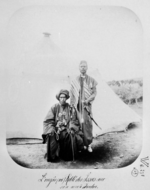
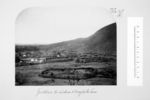

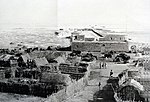
By 1873, the Egyptians peacefully took control of Zeila, Berbera and Bulhar (which was temporarily closed). The Egyptians entered Jaldessa in 1875, and left a small garrison at what would be the seat of Ugaas Robleh Farah.
The Egyptians signed an 1877 treaty with the Gadabuursi, who (with the Issa) accepted Egyptian rule. Before Egyptian occupation, the Issa and Gadabuursi controlled the Zeila-Harar trade route and were responsible for its security.
The Jaarso and the Gurgura clans made peace with the Egyptians for one year to avoid Fitna
Major Hunter, an English Egyptian officer, was sent to Harar in mid-1884 and conducted a number of surveys. According to Hunter, the Issa clan (who numbered about 60,000) lived near the trade routes of Zeila and Harar and were the most dangerous Somali clan; the Habr Awal, who lived between Harar and Berbera, were friendly.
Eliakim Littel (1894) describes the remains of an Egyptian fortress built near Harar to protect the trade routes linking Harar to Zeila from the Gadabuursi:
On the east bank of the Dega-hardani are the remains of a fortress built by the Egyptians during their occupation of this country, of which I shall have more to say. The object of this wayside fort was to protect their trade from the plundering Gadabursi tribe, whose country at this place approaches the road.
Battle of Aussa
Before 1875, the Afar and Ottomans had very little contact with each other (although they had been neighbours). Around 1578, the Ottomans invaded Massawa and other cities on the Red Sea coast.
The battle of Aussa (1875) was fought between the forces of Werner Munzinger and the sultan of Aussa. Munzinger was defeated at Gondet by the Ethiopian Emperor Yohannes IV, and was instructed to lead his forces elsewhere. He arrived in Aussa in 1875, and defeated the Afar garrison for an Egyptian victory.
Battle of Tadjoura
According to survivors, Munzinger, his wife and child arrived in Tadjoura on 5 October to open the roads between Ankober and Tadjoura for contact with King Menelik of Showa; he was also instructed to annex the Afar Sultanate of Aussa and penetrate areas such as Wollo Province. Munzinger's forces consisted of 350 soldiers, two guns, and 45 camels. Reaching Aussa on 14 November, the Egyptian forces were attacked at night by a large number of Gallas. The Afar and Galla forces under Sultan Muhammed Hanfadhe destroyed the Egyptian army, leaving only a small number who fled to Massawa. Amongst those killed were Munzinger and his family.
Soon after the destruction of the Egyptian expedition, Arabs from Mocha (then ruled by the Ottomans) attempted an invasion of Zeila and Aussa. The ulama of Aussa, however, repulsed the Ottoman Yemenis out of their territory. Isma'il Pasha replaced Munzinger with Muhammad Rauf Pasha. Rauf was instructed to lead a large force of Egyptian and Turkish soldiers into southeastern Ethiopia, beginning his conquest of eastern Ethiopia.
Battle of Hakim
The battle of Hakim was fought by the Egyptians and the Harar Oromo tribes. According to the Oromo, their elite were told to approach Mount Hakim to make peace with the Egyptians. However, this was a trap to kill the elite to intimidate the other Oromo in the area. According to the Oromo sources, no Oromo leader in Hakim survived.
Rauf continued to march towards Harar. He received a mid-1875 letter in Arabic from the garad of the Jaarso Adam Ashabbiye, who had participated in skirmishes between the Egyptians and Oromo. The garad praised Rauf in the letter, swearing allegiance and surrendering his kingdom; the garad and his people were Muslims, and did not want to fight the Egyptians. Rauf entered Jarso in early October 1875, and was welcomed by 62 Jaarso leaders who had agreed to surrender their territories to him.
Expeditions into Nole and Ala territory (1874–1875)
In 1874, the Egyptians led a large force from Zeila to Hararghe. The Nole and Ala, the most powerful groups in the region, led a series of campaigns against them.
Jaldessa
Before the Egyptian occupation, Jaldessa and the Harar-Berbera trade route were under Nole Oromo control. According to a report on Harar the Nole Oromo numbered about 142,000 and were centred in Jaldessa (the border between the Issa and Nole). The Nole had subjugated the Issa near Jaldessa, and were the dominant clan there. The Egyptians arrived in Jaldessa in 1875, and peacefully took control of the city around the time the ugaas of the Issa Robleh Farah moved his seat to Jaldessa.
Battle of Gaflole
In September 1875, a large Afran Qallo force under Orfo Jilo Biko ambushed the Egyptian army west of Harar. In the battle the Egyptians captured Ali ibn Abu Bakr, a Harari-Oromo nobleman. Ali ruled the territory of Igu, and was the cousin of the emirs of Harar and Zeila. When Rauf invited the Harari leaders to discuss the occupation, Ali Abu Bakr offered to betray his cousin.
Battle of Iftur
On September 24, Afran Qallo soldiers arrived at Mount Hakim and Iftur. Oromo leader Orfo Jilo Biko attacked both Egyptian flanks, but Rauf's firepower destroyed his cavalry and archers. Rauf sent his artillery to Mount Hakim, site of the battle of Hakim.
Battle of Eguu
The battle of Eguu was significant in Nole history. The Nole Oromo led their army into the outskirts of their territory at Eguu (thirty miles west of Harar), which the Egyptians planned to attack. Egyptian firearms beat back the Nole cavalry, since their horses were afraid of the noise. After seven hours, the Nole army was destroyed.
Battle of Abgou
The Battle of Abgou was fought on October 8, soon after the battle of Eguu. The Ala and Nole Oromo allied and led a large force of Oromo soldiers who blocked roads and defeated the Egyptians. The following day, 37,000 Ala and Nole cavalry and infantry awaited the Egyptians near Abgou. Rauf reported that the Egyptians opened heavy fire on the Oromo; after seven hours and 10 minutes, the Oromo sent their women to surrender. The Egyptians requested that the Nole and Ala send their leaders. The Ala sent Al Buku Raya, and the Nole sent Uthman Yaro and Ali Karow. The Nole representatives asked for mercy, but their request was ignored. In spring 1882, the Egyptians destroyed a Metta (Ala) and Oborra Oromo force at Chelenqo and subjugated the Oborra and Ala tribes.
Battle of Dire Gofile
The battle of Dire Gofile was the most important battle between the Oromo of Harar and the Egyptians. Rauf ordered the Egyptians to rush to Dire Gofile, deep in Nole territory (east of Harar), after the battle of Hakim in an attempt to intimidate the Nole Oromo; he also took advantage of Oromo leader Orfo Jilo Bikos' presence in the region. Bikos had left his main force, which was fighting the neighbouring Issa Somali, in the Ogaden desert. The small Oromo force eventually surrendered; its leaders, including Orfo Jilo Biko, Garad Jibril, Ali Abu Bakr, and Garad Adam Asihabiyye, were captured and sent to Cairo. After the battle, the Egyptians marched into Harar with little Oromo resistance. The four Nole tribes, the 12 Ala tribes, the three Berteri tribes, the two Babile tribes, the seven Abiba tribes, the three Hiri tribes, and the Abuba, Ittu and Zaho Jarelo Oromo tribes surrendered on October 11, 1875.
After conquering Harar, Rauf killed the emir and the Oromo leaders who did not surrender and declared himself emir of Hararghe. He subdued every Oromo tribe, suppressing all rebellions to end Egyptian rule.
Aftermath
British occupation (1880–1885)
After occupying the Khedivate of Egypt, the British controlled the Hararghe and Somaliland. They sent expeditions to the Barento, the only Oromo to resist the British occupation. Amir Abdullahi was the last emir of Harar, and with Oromo support pushed the Egyptians and British out of Harar to Mount Hakim.
Garad/Sultan Adam Asshabiye, the ruler of the Jarso, made peace with the Egyptians, however his son Aaqil (Muhumad) and successor continued resistance.
British and French involvement (1885)
During the mid-1880s, Mahdism took control of Sudan and much of Egypt; however, it was unsuccessful in Harar. Major Hunter recommended that the British governor of Harar return independence to the Somalis. Hunter's main concern was Berbera, as rumours spread about the Egyptian disaster in the Sudanese ports. Hunter said that Emir Abu Bakr of Zeila, an Afar businessman, influenced the Issa and Afar. Hunter warned the Egyptians that Abu Bakr was probably planning an invasion of Berbera. In March 1884, Hunter returned to Aden and established himself as the first British governor of Harar. He described the bey of Berbera as an incautious, suggestible and corrupt ruler, and described Emir Abu Bakr as a powerful man who controlled the slave trade along the Somali coast. That year, the Capuchins arrived in Harar without telling the Egyptians; their mission was successful in Berbera, but failed in Zeila. The Egyptians were afraid that the French church would spark a religious war, and did not provide the church with security in or near Harar. In 1884 they had left Berbera, and the British agreed with the Habr Awal to remain in Berbera. Hunter returned from Aden in August 1884, and ordered Nuba Pasha to evacuate Zeila; this was impossible, however, due to Emir Abu Bakr's influence on the area's Somali tribes. Abu Bakr tried to earn Hunter's favour, and gave him economic resources; he requested Egyptian protection, and told Hunter that he would not continue as ruler of Zeila. On 27 October 1884, the Egyptians left Sagallo; Abu Bakr told the British that the next night, the French planted their flag in the area. Although it was Abu Bakr's duty to work with the British, he was also secretly working with the French in Djibouti. Abu Bakr succeeded Haji Ali Sharmarke Saleh, had gained the respect of the Issa and Afar, and controlled Tadjoura and Zeila from 1860 to 1884; he also controlled the lucrative Red Sea slave trade.
Gallery
-
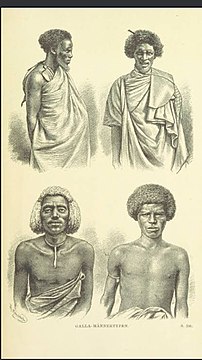 Oromo men in Harar during the Egyptian era
Oromo men in Harar during the Egyptian era
-
 Oromo Garad Abu Bakr Liben of a village northwest of Harar (1885)
Oromo Garad Abu Bakr Liben of a village northwest of Harar (1885)
-
 19th-century map by Richard Francis Burton with the Nole, Issa, Gadabuursi, Jarso, and Gheri Oromo-Somali tribes
19th-century map by Richard Francis Burton with the Nole, Issa, Gadabuursi, Jarso, and Gheri Oromo-Somali tribes
-
 Abu Bakr in 1877
Abu Bakr in 1877
-
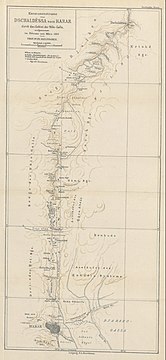 Map of the Hararghe, including territories of the Nole and Ala Oromo
Map of the Hararghe, including territories of the Nole and Ala Oromo
-
 Werner Munzinger in 1873
Werner Munzinger in 1873
References
- Caulk, Richard A. (1971). "The Occupation of Harar: January 1887". Journal of Ethiopian Studies. 9 (2): 1–20. JSTOR 41967469.
- Dunn, John P. (2005). Khedive Ismail's Army. Psychology Press. p. 108. ISBN 9780714657042. Retrieved 18 February 2022.
- Ben-Dror, Avishai (23 August 2018). Emirate, Egyptian, Ethiopian: Colonial Experiences in Late Nineteenth-Century Harar. Syracuse University Press. ISBN 9780815654315.
- Kohn, George Childs (2013-10-31). Dictionary of Wars. Routledge. ISBN 978-1-135-95494-9.
- Ben-Dror, Avishai (2018-08-23). Emirate, Egyptian, Ethiopian: Colonial Experiences in Late Nineteenth-Century Harar. Syracuse University Press. ISBN 978-0-8156-5431-5.
- ^ Dumper, Michael (2007). Cities of the Middle East and North Africa: A Historical Encyclopedia. ABC-CLIO. ISBN 978-1-57607-919-5.
- ethiopianhistory.com. Retrieved 2021-06-01.
- Reid, Richard J. (2011-03-24). Frontiers of Violence in North-East Africa: Genealogies of Conflict Since C.1800. Oxford University Press. ISBN 978-0-19-921188-3.
- Ahmed, Wehib (October 2015). "History of Harar and Hararis" (PDF). Everything Harar. Revised Version.
- "Asafa Jalata". The Conversation. 10 August 2016. Retrieved 2022-07-14.
- Jalata, Asafa (2020-02-28). The Oromo Movement and Imperial Politics: Culture and Ideology in Oromia and Ethiopia. Rowman & Littlefield. ISBN 978-1-7936-0338-8.
- Lewis, I. M. (2017-02-03). Peoples of the Horn of Africa (Somali, Afar and Saho): North Eastern Africa Part I. Routledge. ISBN 978-1-315-30817-3.
- Mukhtar, Mohamed Haji (2003-02-25). Historical Dictionary of Somalia. Scarecrow Press. ISBN 978-0-8108-6604-1.
- Ben-Dror, Avishai (2018-08-23). Emirate, Egyptian, Ethiopian: Colonial Experiences in Late Nineteenth-Century Harar. Syracuse University Press. p. 170. ISBN 978-0-8156-5431-5.
- Laitin, David D.; Lattin, David C.; Laitin, James T. Watkins IV and Elise V. Watkins Professor of Political Science David D. (May 1977). Politics, Language, and Thought: The Somali Experience. University of Chicago Press. ISBN 978-0-226-46791-7.
- Nieuważny, Adam (2021-11-01). Civil status documents from Harar under Egyptian Administration 1875-1885. Department of Arabic and Islamic Studies, University of Warsaw. ISBN 978-83-954430-8-4.
- Lewis, I. M. (1999). A Pastoral Democracy: A Study of Pastoralism and Politics Among the Northern Somali of the Horn of Africa. LIT Verlag Münster. ISBN 978-3-8258-3084-7.
- ^ Ben-Dror, Avishai (2018-08-23). Emirate, Egyptian, Ethiopian: Colonial Experiences in Late Nineteenth-Century Harar. Syracuse University Press. ISBN 978-0-8156-5431-5.
- Ben-Dror, Avishai (2018-08-23). Emirate, Egyptian, Ethiopian: Colonial Experiences in Late Nineteenth-Century Harar. Syracuse University Press. p. 173. ISBN 978-0-8156-5431-5.
- Littel, E, et al (1894). Littell's Living Age. p. 219.
On the east bank of the Dega-hardani are the remains of a fortress built by the Egyptians during their occupation of this country, of which I shall have more to say. The object of this wayside fort was to protect their trade from the plundering Gadabursi tribe, whose country at this place approaches the road.
{{cite book}}: CS1 maint: multiple names: authors list (link) CS1 maint: numeric names: authors list (link) - ^ Holt, Peter Malcolm; Lambton, Ann K. S.; Lewis, Bernard (1977). The Cambridge History of Islam. Cambridge University Press. ISBN 978-0-521-29137-8.
- Kohn, George Childs (2013-10-31). Dictionary of Wars. Routledge. ISBN 978-1-135-95501-4.
- Poluha, Eva (2016-01-28). Thinking Outside the Box: Essays on the History and (Under)Development of Ethiopia. Xlibris Corporation. ISBN 978-1-5144-2223-6.
- Wylde, Modern Abyssinia, p. 25.
- Britain), Royal Geographical Society (Great (1876). Proceedings of the Royal Geographical Society of London. Edward Stanford.
- Edward Ullendorff, The Ethiopians: An Introduction to Country and People, second edition (London: Oxford University Press, 1965), p. 90. ISBN 0-19-285061-X.
- "Muhammad Rauf Pasha", Misplaced Pages, 2021-11-05, retrieved 2021-12-22
- Hecht.
- Ben-Dror, Avishai (2018-08-23). Emirate, Egyptian, Ethiopian: Colonial Experiences in Late Nineteenth-Century Harar. Syracuse University Press. ISBN 978-0-8156-5431-5.
- Ben-Dror, Avishai (2018-08-23). Emirate, Egyptian, Ethiopian: Colonial Experiences in Late Nineteenth-Century Harar. Syracuse University Press. p. 89. ISBN 978-0-8156-5431-5.
- Ben-Dror, Avishai (2018-08-23). Emirate, Egyptian, Ethiopian: Colonial Experiences in Late Nineteenth-Century Harar. Syracuse University Press. p. 90. ISBN 978-0-8156-5431-5.
- Ben-Dror, Avishai (2018-08-23). Emirate, Egyptian, Ethiopian: Colonial Experiences in Late Nineteenth-Century Harar. Syracuse University Press. ISBN 978-0-8156-5431-5.
- Ben-Dror, Avishai (2018-08-23). Emirate, Egyptian, Ethiopian: Colonial Experiences in Late Nineteenth-Century Harar. Syracuse University Press. p. 59. ISBN 978-0-8156-5431-5.
- Scottish Geographical Magazine. Royal Scottish Geographical Society. 1885.
- Society, Haile Sellassie I. University Ethnological (1957). Bulletin.
- Ben-Dror, Avishai (2018-08-23). Emirate, Egyptian, Ethiopian: Colonial Experiences in Late Nineteenth-Century Harar. Syracuse University Press. ISBN 978-0-8156-5431-5.
- Nieuważny, Adam (2021-11-01). Civil status documents from Harar under Egyptian Administration 1875-1885. Department of Arabic and Islamic Studies, University of Warsaw. ISBN 978-83-954430-8-4.
- Ben-Dror, Avishai (2018-08-23). Emirate, Egyptian, Ethiopian: Colonial Experiences in Late Nineteenth-Century Harar. Syracuse University Press. ISBN 978-0-8156-5431-5.
- Dunn, John P. (2005). Khedive Ismail's Army. Psychology Press. ISBN 978-0-7146-5704-2.
- Dunn, John P. (2005). Khedive Ismail's Army. Psychology Press. ISBN 978-0-7146-5704-2.
- The Journal of Oromo Studies. Oromo Studies Association. 2008.
- ^ Nieuważny, Adam (2021-11-01). Civil status documents from Harar under Egyptian Administration 1875-1885. Department of Arabic and Islamic Studies, University of Warsaw. ISBN 978-83-954430-8-4.
- Huntingford, G. W. B. (2017-02-10). The Galla of Ethiopia; The Kingdoms of Kafa and Janjero: North Eastern Africa Part II. Routledge. ISBN 978-1-315-30809-8.
- Rimbaud, Arthur (2004-09-02). Selected Poems and Letters. Penguin UK. ISBN 978-0-14-193234-7.
- ^ Ben-Dror, Avishai (2018-08-23). Emirate, Egyptian, Ethiopian: Colonial Experiences in Late Nineteenth-Century Harar. Syracuse University Press. ISBN 978-0-8156-5431-5.
- Journal of Ethiopian Studies. Haile Selassie I University, Institute of Ethiopian Studies. 1974.
- J. Spencer Trimingham, Islam in Ethiopia (Oxford: Geoffrey Cumberlege for the University Press, 1952), pp 120f.
- Ben-Dror, Avishai (2018-08-23). Emirate, Egyptian, Ethiopian: Colonial Experiences in Late Nineteenth-Century Harar. Syracuse University Press. ISBN 978-0-8156-5431-5.
- Zewde, Bahru (2002-03-17). A History of Modern Ethiopia, 1855–1991. Ohio University Press. ISBN 978-0-8214-4572-3.
- Wehib M. Ahmed (October 2015), History of Harar and the Hararis (PDF), Harari People Regional State Culture, Heritage and Tourism Bureau, retrieved 2020-12-14 (PDF).
- CAULK, RICHARD A. (1971). "The Occupation of Harar: January 1887". Journal of Ethiopian Studies. 9 (2): 1–20. ISSN 0304-2243. JSTOR 41967469.
- Ben-Dror, Avishai (2018-08-23). Emirate, Egyptian, Ethiopian: Colonial Experiences in Late Nineteenth-Century Harar. Syracuse University Press. p. 175. ISBN 978-0-8156-5431-5.
- Ben-Dror, Avishai (2018-08-23). Emirate, Egyptian, Ethiopian: Colonial Experiences in Late Nineteenth-Century Harar. Syracuse University Press. p. 175. ISBN 978-0-8156-5431-5.
- Ben-Dror, Avishai (2018-08-23). Emirate, Egyptian, Ethiopian: Colonial Experiences in Late Nineteenth-Century Harar. Syracuse University Press. ISBN 978-0-8156-5431-5.
- Ben-Dror, Avishai (2018-08-23). Emirate, Egyptian, Ethiopian: Colonial Experiences in Late Nineteenth-Century Harar. Syracuse University Press. p. 189. ISBN 978-0-8156-5431-5.
- Woolf, Leonard (2018-05-03). Empire and Commerce in Africa: A Study in Economic Imperialism. Routledge. ISBN 978-1-351-02236-1.
- Bezabeh, Samson (2016). Subjects of Empires, Citizens of States: Yemenis in Djibouti and Ethiopia. p. 18.
- Lewis, I. M. (2019-05-20). A Modern History Of Somalia: Nation And State In The Horn Of Africa, Revised, Updated, And Expanded Edition. Routledge. ISBN 978-0-429-71282-1.